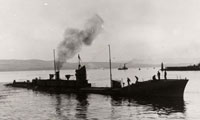
K4, one of the submarines sunk in the Isle of May debacle. Photograph: The Royal Navy Submarine Museum
There was no actual battle at the Isle of May in the Firth of Forth off Scotland. Nevertheless, on the night of January 31st and the morning of February 1st, 1918, 270 sailors of the Royal Navy lost their lives off the Isle of May in five collisions between eight different vessels. Two submarines sank and three more subs and a destroyer escort were damaged. No enemy vessels were involved. The ships involved in the collisions were among 40 naval vessels which left Rosyth, Scotland for exercises in the North Sea. The accidents were kept secret and many of the details of the incident were not revealed until the 1990s. A memorial cairn was finally erected 84 years later, in 2002 at Anstruther harbor opposite the Isle of May.
Now the site of the accidents is being surveyed by divers to ensure that a planned offshore wind farm does not disturb the wreckage.
Divers survey Scottish graveyard of first world war submarine disaster
In January 1918, as British warships steamed north from Rosyth to join their fleet at Scapa Flow in the Orkneys, they were accompanied by two flotillas of the submarines. The first two subs found themselves bearing down on two minesweepers and changed course. The third, K14, veered to starboard to avoid colliding with them but performed a complete circle as its rudder jammed.
That brought it back into line just in time to be rammed by the last submarine in the group, K22. A battlecruiser, HMS Inflexible, then ploughed into K22.
The first ships in the convoy turned back to rescue the submarines and steamed straight into the chaos. A cruiser, HMS Fearless, rammed K17, another of the subs, sinking it within eight minutes. Then two further submarines, K4 and K6, collided. To complete the disaster, a destroyer then carved through the survivors of K17, killing many of those who had been left in the water. The entire 59-man crew of K4 was lost and all but eight of K17’s.
The Royal Navy hushed up the catastrophe and it was not until 2002 that a commemorative plaque was erected on a cairn in Anstruther, the nearest village on the coast, though even that does not refer to the cause of the loss of life. The Submariners’ Association does, however, now hold an annual commemorative service.
The site of the two sunken submarines, 100 metres apart and about 50 metres down, has long been known, but the wrecks have now been surveyed by divers from the specialist marine consultants EMU. The area is the proposed site for an offshore windfarm, known as the Neart na Gaoithe project, developed by a company called Mainstream Renewable Power.
